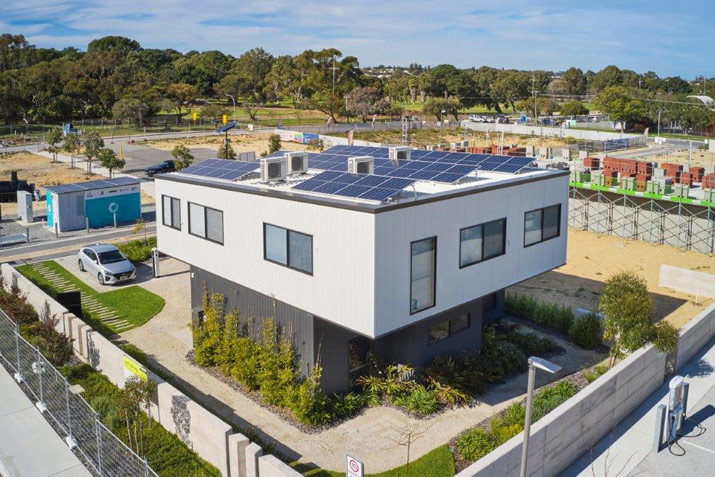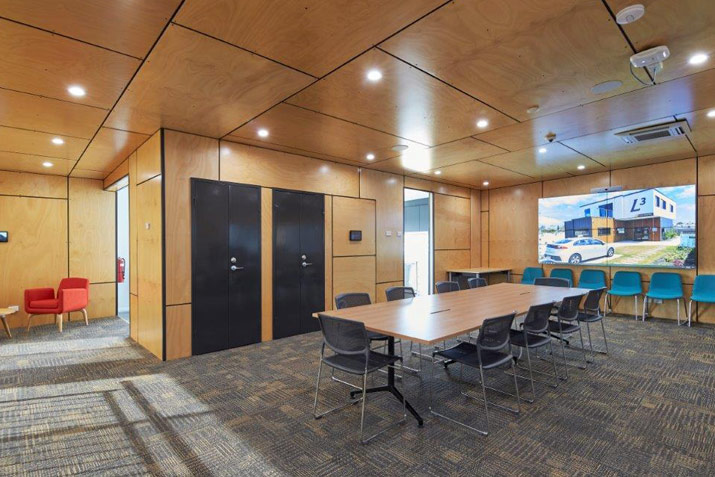

Fleetwood’s Western Australian yard proved the inspiration behind Legacy Living Lab (L3) for two Curtin University PhD students and a professor after noticing several unused heavy gauge steel frames. The PhD students utilised the frames as the inspiration behind a building dedicated to researching how we should build for the sustainable future: a circular economy.
Innovation takes shape in many forms, and particularly when the right mix of cooperation and vision combine in the building space – it’s an enterprising outcome. The innovative industry/academia partnership between Fleetwood Building Solutions and Curtin University that gave rise to the project is a strong case study and was forged through an initiative by The ARC Training Centre for Advanced Manufacturing of Prefabricated Housing (CAMP.H).
Living Legacy Lab (L3) is the ‘child’ of this unique project and is the case study for Curtin PhD students Roberto Minunno (ideator), Tim O’Grady (Project Manager) and Greg Morrison (Project Director). It has also been influenced by fellow PhD student and Interior designer Emma Whettingsteel.
The final result is a showcase of insight and lateral thinking that will assist the building industry in the inevitable transition to a carbon-neutral circular economy.
Fleetwood became one of the project’s major sponsors, contributing drafting and project management time and was also responsible for constructing and installing L3.

Concerns over how to deal with the excess from our building projects are not new, and concepts such as “zero waste” have held currency for some time. Still, now the thinking is turning to the term ‘circular economy’ (CE), an approach that envisions buildings as repositories of value.
Take a look at the activities at any traditional construction or demolition site, and the evidence of waste created by the building industry is increasingly mounting.
By contrast, imagine a world where demolition will be minimised and building design will deliberately enable future disassembly or reconfiguration. With the conception of L3 and the ideology behind it – the future has arrived.

Industry partner
The project was sparked by a builder going into liquidation. Project Manager Tim O’Grady comments, “Our industry partner Fleetwood was left with several heavy gauge steel frames destined for the project sitting in their yard and destined to be cut up and recycled. Roberto had the idea to turn the failure into a success and try to raise funding to demonstrate that CE can be achieved in the construction industry, especially in the Prefab Construction industry.”
“Our PhD case study, the L3, is an example of what we can achieve in terms of circularity of materials,” says Dr Minunno. “Waste from the construction industry represents about 40% of waste worldwide. The circular economy is a theoretical framework that attempts to turn waste into new resources, with the potential to decrease waste production and related land pressure and material depletion. Traditional buildings, however, are not fit for a circular economy. On the other hand, modular buildings can be designed for disassembly and reuse, but few examples have been constructed to date.
Our project demonstrates the material saving and related saving in carbon emissions that can be obtained redesigning and rethinking the way we build.”
The building was constructed using eight steel-framed modules in Fleetwood’s factory and was designed to load and unload from trucks easily.

The L3 project was conceived through the life cycle thinking, with the first life cycle having commenced in 2019.
“Traditional buildings are built to last a number of years, depending on where they are located and how they are built. Typically, buildings are designed in a linear fashion: they are built, used and then disposed of in landfills. Some materials are recycled; however, often, material quality decreases owing to recycling processes.
We define a traditional building lifecycle as the time between construction and disposal. Instead, the L3’s circular model means it can be disassembled and reused multiple times, in different locations and for different purposes.

The first life cycle is situated at East Village in Knutsford, a DevelopmentWA redevelopment site in Fremantle, WA. DevelopmentWA supported this ambitious project through $100,000 of funding and a three-year lease. After this period, it will be moved to its second location and start a second lifecycle resulting in waste production being minimised in this process.”
O’Grady adds that the internal walls’ cladding is plywood, so they can be easily removed to minimise waste. However, the details extend well beyond this. “The wall frames have been cut into 1200 mm sections to accommodate a change in building layout, while the flashings have been designed, so there is no disruption to waterproof membranes during transportation, and the process is based around zero waste.”
Ongoing evaluation of L3’s building performance is also a key consideration of the build with aesthetics, materials, cost-effectiveness, energy efficiency and performance, lighting, acoustic and thermal comfort to be monitored. Most recently, the project is tracing heat transfer through windows with and with without blinds prior to being swapped out for double glazed windows
On reflection of their involvement, Michael Colling, Executive General Manager National sales at Fleetwood Building Solutions, said: “We learnt about new and recycled materials that have rarely been used in modular manufacturing. The collaborative focus on the circular economy and aims of zero carbon footprint projects and communities has sharpened our knowledge and expertise in this area.
With sustainability and enhanced environmental performance targets becoming increasingly important for our business partners, this has been an invaluable partnership for Fleetwood.
Our contribution to L3 will assist us in years to come. We are looking forward to seeing the performance data come through for the different materials used this landmark building project – it will inform our product development for decades to come.”
See: www.fleetwood.com.au
Click Here to return to the home page for more articles.